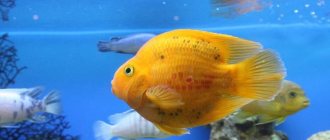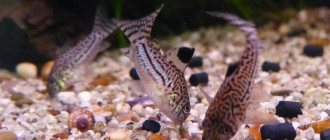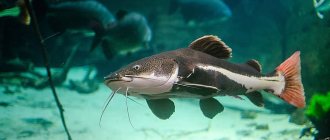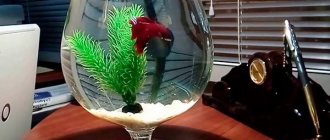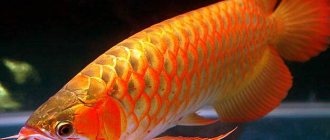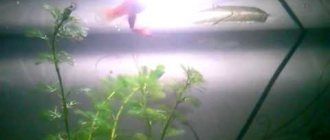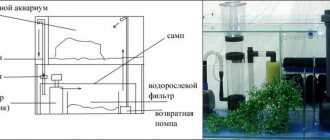The article contains fascinating material about three-hybrid parrotfish - exotic and spectacular inhabitants of the aquarium. Beginners and experienced aquarists alike are captivated by bright and colorful funny fish. Asian breeders made peace-loving parrots popular for the sake of commerce by deforming their body and depriving the males of the ability to fertilize, but giving them an original appearance.
| Full name | Parrotfish. Parrot fish. |
| Kinds | ● Cone-headed; ● Cetoscar – 2; ● Chlororus – 18; ● Hipposcars – 2; ● Skarov – 52; ● Calotoms – 5; ● Cryptotomuses; ● Leptoscarov; ● Nikolsinov – 2; ● Sparisomas – 15 species. |
| Color | Natural colors are yellow and red. The other color is artificially created and gradually becomes pale. |
| Water | t (temperature) 24–28 degrees; pH (balance of acid and alkali) from 6.5 to 7.5. kH (hardness level) from 5 to 7. |
| Feed | In nature, they feed on coral polyps, mollusks and bottom animals. Aquarium fish are fed dry and live food: bloodworms, tubifex, shrimp, frozen minced sea fish and always fresh herbs. |
| Compatibility | Suitable neighbors: barbs, catfish, ostronotus, black knives, aquarium arowanas, cichlids. You cannot add fish that are 5 cm or smaller in size. |
| Lifespan | 7-10 years |
Description and habitat
In the wild, parrotfish live on shallow reefs of tropical zones in the Indian and Pacific Oceans. They are found in the Mediterranean, Caribbean and Red Seas, but their favorite place is coral reefs.
Parrot fish have a specific structure of teeth, which are ground down with a special biomaterial. Therefore, a wild parrot fish cannot live at home.
Appearance
Red Parrot grows up to 30 cm, aquarium species up to 12-20. The main differences between cichlases are the shape and color of the body. Because of the shape of the head, similar to a bird's beak, the fish was called a parrot. And since the stable color of fish is red, it turned out: Red Parrot. If the fish does not feed properly, the color will turn orange.
The hybrid parrot fish, the photo of which is presented below, is different:
- rounded, slightly flattened barrel-shaped body;
- irregular spine;
- a small triangular mouth, which makes it difficult to take food;
- small, even fins, in some fish they look like a train;
- variety of colors.
Features of behavior
Red parrots are not aggressive fish, even friendly, they do not touch a person swimming nearby.
But if the fish is touched or frightened, it will bite and even hit with its tail fin.
In the aquarium, parrots are peaceful and allow their owner to pet them. Only males become aggressive during the spawning period.
Diet of Pelvikachromis pulchera
Fish are not picky about their diet. The usual diet of pelvicachromis consists of live or frozen bloodworms, tubifex, daphnia, and in small quantities enchytraea. In their absence, scraped meat can be given. Balanced dry food also eats well. For the full development of fish, it is advisable to include plant nutrition in the diet, including dry food based on spirulina. With a well-composed diet that includes a sufficient amount of ingredients of plant origin, parrots never bite even such soft-leaved plants as limnophila.
Types and colors of parrots
The three-hybrid parrot is considered an artificial species, which was bred in Taiwan in the mid-20th century. By crossing representatives of three closely related species, we obtained a hybrid Red Parrot, which is unable to live outside an aquarium and survive in the fight against natural competitors. It is unknown who the ancestors of the hybrid are, but presumably – Lemon and Rainbow cichlazomas or Red-headed.
The classification is related to the body color of parrot fish. Natural colors are red, orange, yellow and white.
Purple, green, blue and variegated colors are made artificially; such colors fade early.
In the second classification, the fins are noted and the species are named:
- marble;
- panda parrots;
- unicorns;
- tailless parrots;
- King Kong;
- red ingot;
- diamond or pearl parrot.
Aquarium fish parrots are represented by hundreds of species. Most Popular:
Red
Popular view. Prized for its bright red color, curved spine and dorsal hump. Body length is no more than 25 cm. The eyes are large with a wide iris.
Blue
A bright blue fish with a translucent large veil fin. Wild species are large, aquarium species - 15 cm.
Diamond or pearl
Body color is blue and bright red with all shades of these colors and always with spots. The length of wild fish is 3 cm, domestic fish - 15.
Yellowbellied
Otherwise called Kribensis yellow-bellied or Yellow. It is friendly with other species, but it is difficult to put up with relatives. The body length of these fish is no more than 13 cm. The body of males has vertical stripes; females are distinguished by their pink abdomen.
Golden-headed
A parrot fish, 10 cm long, golden in color, lives in Nigeria. The gill covers are greenish. The dorsal fin has red stripes.
Cameroonian
This parrot fish is also 10 cm long. The back is dark purple, the belly is blue and has a green tint. There is a dark stripe running down the body.
Black-spotted
Adult fish are 25 cm long. There is a large black spot in the center of the grey-brown body, other spots surround the large eyes.
Roloff
The body is light purple, length 8 cm. The abdomen of the female is purple, the fins are orange. There is a black stripe running down the body.
Reticulate
Fish up to 10 cm long.
The body of males is gray and yellow, the back is purple. Scales and fins with a red border. Females have golden fins and a burgundy belly.
Red-lipped
Lives in Guinean waters. There are 7 vertical stripes visible on the body. The fins themselves have dark spots. The fish are difficult to keep, aggressive, and dig heavily in the soil.
Sylvia
The body length of males is 8 cm, females are 4-5 cm. The color is pale or yellow-brown, with two dark stripes along the body. The stripes disappear during courtship, and become vertical when the fry emerge. The female is distinguished by its red or purple abdomen. The male has a red anal fin with blue dots.
Albino
There is no coloring. The fry are just as pale: the gray body is marked only by a dark stripe. An albino male chooses a white female to breed.
Interesting fact: when the red parrot gets ready to sleep, it secretes mucus through its mouth to form a protective cocoon against blood-sucking isopods.
Genetic diagnosis of sex
One of the most reliable ways to distinguish between female and male budgerigars is genetic research. This method of sex determination is based on the study of the properties inherent in the bird: the number of chromosomes in males and females differs. This only works in a few varieties resulting from gene mutation:
- cinnamon (brownish waves on feathers);
- opaline (there is no pattern between the wings);
- lutino (yellow feathers);
- albino (white with a bluish tint);
- slate (gray with turquoise splashes);
- Texas Celandine (blurred color, brighter shade on the lower body).
The chromosome set is checked in the laboratory, but even at home, you can sometimes distinguish a boy from a girl parrot by the color of its feathers. To do this, the chick must grow feathers. In this case, it is necessary to see a couple of breeding birds, that is, this method is suitable for breeders.
How to determine the sex of a parrot based on the color of the parents:
- Dad and mom are normal, but the chick is cinnamon or opaline in color, which means it’s a girl.
- The male is opaline, and the female is normal - individuals of the opaline species will be girls, and normal ones will be boys.
- The red-eyed cub of normal parents is a female, most often her color is lutino or albino.
The sex of a parrot is determined by the shape of its head and the color of its legs. Boys' paws are blue, and their heads are large and have a flattened crown. Girls have pink fingers, a pointed forehead and a flat nape.
Selection and arrangement of an aquarium
The red parrot is a picky fish and adapts to the conditions that are offered to it. Therefore, caring for it is not burdensome if you also use secrets and subtleties.
Volume
Parrot fish are active pets of large sizes; they require a lot of space for play and free movement. The best option would be a 200-liter aquarium with a length of at least 70 cm, covered with a lid so that the fish do not jump out when playing around.
Equipment (with example models)
For the normal maintenance of parrots, the aquarium must be equipped with:
- a filter to remove waste, which fish leave behind a lot;
- a compressor or aerator to saturate the water with oxygen;
- a lamp for dim illumination (0.3-0.5 watts per liter), so the color of the parrots will not fade; it is desirable that the red spectrum predominates in the lighting;
- thermostat;
When buying a filter, take into account the size and capacity of the aquarium. A weak device will not cope with sufficient cleaning, and installing a powerful device threatens a strong current, which the red parrot does not like.
Models:
- Rarely used bottom filters are designed to be laid underground;
- if you have a compressor, use an inexpensive airlift filter with a sponge;
- some purify water using a hanging filter (“backpack”), hanging it outside;
- external filter, canister with filter media, operates silently, installed under the aquarium in a cabinet.
In still water, where there is not enough oxygen, harmful substances and bacteria accumulate. The compressor supplies air inside the aquarium, saturating it with oxygen and creating continuous movement of water.
When choosing a device, it is worth asking about the noise it creates. It is also advisable to pay attention to the presence of power adjustment.
If the aquarium is already equipped with a filter with an aeration function, then it is not necessary to acquire a compressor.
Compressor devices are available with pistons or membranes, differ in cost and noise emission, as well as location inside or outside. The internal compressor is a pump with a rotating element.
To maintain the desired temperature, use an aquarium heater or thermostat, which is selected based on the volume of the container.
It is allowed to take a device with high power, then it will turn on less often. It is better if the device has a regulator to set the desired temperature.
In addition to devices, you will need other devices for caring for parrot fish in an aquarium. Therefore, it’s also worth getting:
- socket with timer;
- water thermometer;
- net;
- siphon;
- tweezers;
- special scraper;
- plastic bucket, preferably two.
You will have to spend money first to start the aquarium, then these items will serve for a long time.
Water requirements
Parrots require certain levels of water to live comfortably. These fish are heat-loving, so the temperature is maintained from 22 to 27 degrees, with an acidity not higher than 7.5. The permissible level of hardness is from 2 to 25 units, but preferably within 2-5.
Renew water by 30-50% once a week. Be sure to check for contamination with phosphates and nitrogen compounds. For this you will need drop tests. To remove harmful impurities, it is recommended to use neutralizers with the addition of vitamins and treats for fish.
Plants, decorations and soil
Parrots are indifferent to plants and a large number of decorations, although everyone tries to get their own home.
To do this, the aquarium is decorated with fragments of pots and artificial driftwood. The most suitable plants are hard-leaved species: Cryptocoryne, Echinodorus and Anubias, which need to be firmly fixed. Instead of living plants, specimens of artificial algae are often installed
For soil with a layer of at least 5 cm, where parrots like to dig and dig nests, medium-sized smooth pebbles mixed with sand are suitable.
The most accurate method is DNA analysis
The DNA test guarantees the accuracy of the research. With its help, the probability of distinguishing the gender of budgerigars is very high. Feathers, blood, and egg shells are suitable for analysis. In terms of the reliability of the result, blood and feathers are identical, but the shell is only suitable if the inner membrane is preserved.
Tips for collecting feather material:
- the fallen feather is not used for dough; healthy, medium-sized feathers are plucked out;
- the fluff from under the wings is not suitable;
- The tip of the pen should be white.
Important: if there are drops of blood left on the feathers, they should not be washed off. Such material is suitable for analysis.
Instructions for taking blood samples:
- the device for cutting nails is sterilized;
- wipe the claws with alcohol;
- The cutting site is chosen at the tip of the claw, where the vessel passes.
After the manipulations, the material is sent to the laboratory.
DNA testing is expensive, exceeding the price of the bird itself. This method is rarely used, mainly if it is important to determine the sex of parrots. It is not advisable to order a DNA testing procedure just out of curiosity.
It is more difficult to tame an adult bird than a young one. If you need a feathered pet to teach it to imitate human speech, choose a male at the age of three to four months. Now you have complete information on how to determine the sex of a budgie.
Maintenance and care
What to feed
Considering the special structure of the mouth of parrots, food should be chosen correctly and given in crushed form. These fish are fed with gammarus, bloodworms, aulophus, and Tetra granulated food for parrotfish. Homemade minced meat is made from live sea fish and frozen. The main thing is variety: alternate dry food with live bait.
It should be borne in mind that some fish like protein-based food, while others choose plant foods.
Allowed to feed:
- peas;
- zucchini;
- corn;
- bell pepper;
- dandelion;
- lettuce leaves.
In order not to overfeed, otherwise the pets will become fat, food is given fractionally in the morning and in the evening. The remains are removed.
How to maintain natural color
The color of the fish changes over time. This is influenced by the age and conditions in which parrots are kept without artificial coloring. To keep the color bright longer, it is useful to add shrimp to the food, removing the shell, live greens, or purchase specialized food with natural dye.
When caring for budgerigar fish, it is worth knowing that the reason for the color fading is low temperature or bright lighting. And dark soil or the background of the aquarium will help highlight the brightness of the color.
How long do parrot fish live?
Despite artificial changes in aquarium parrots, the fish are able to live up to eight years. Proper care extends the lifespan to 10 years.
Compatibility with other fish
Parrots are considered peace-loving fish, but like all cichlids, they do not get along with strangers, not wanting to share their own territory. Therefore, they are housed with fish of the same size that inhabit other water layers. This is how parrots get along:
- with mossy and Sumatran barbs;
- with cichlids of another species;
- with swordtails;
- with mollies;
- from Congo.
Not against catfish, razorbacks, black knives and arowanas. The main thing is that the aquarium is not crowded, and that the parrots have enough of their own territory and shelters. Cichlids do not like slow-swimming fish, and simply eat shrimp and small fish. Parrots do not get along with angelfish, spotted acaras and some cichlids.
Compatibility with other fish
Compatible
For the Pelvikachromis pulcher fish, compatibility with other species is not a problem, since it is not an aggressive cichlid. It is better to keep individuals in pairs. They can also be raised with other fish, but the aquarium must have enough space so that each can have its own territory. Cichlazomas get along well with species such as tetras, barbs, zebrafish, and rasboras. And also with common gourami, catfish and plecostomus.
Not compatible
Do not keep very small or invertebrate species with Pelvicachromis pulcher, as they will be eaten.
Reproduction and breeding
It will not be possible to breed red parrots on your own, because hybrid males are not capable of fertilization.
If the eggs are fertilized by a male relative, the fry will appear, but they will not look like the mother.
Sex differences
Until 1.5 years old, it is not possible to distinguish between a boy and a girl parrot. This can only be done when spawning begins. First, in the male, closer to the tail, a cone-shaped protrusion appears; in the female, it looks like a pear. Then the male is distinguished by the appearance of a sharp and narrow vas deferens, the female by the wide and short ovipositor, like a tube.
Other characteristics of a male parrot include:
- large body size;
- pointed caudal fin;
- bright color;
- activity during nest construction.
Preparing fish and aquarium for spawning
Sexually mature red (Japanese) parrots, as can be seen from their brighter colors, unite in pairs and begin to prepare nests. Preparation lasts 3 days. The male widens the entrance to the shelter, cleans the floor and walls.
How does spawning happen?
Egg laying begins in the evening. The future father follows the female and tries to fertilize, without missing, every egg, of which 300 are spawned. If all else fails, the eggs die after 2 days.
In nature, parrots swim in flocks to spawn. It happens that there is not a single male there.
In this case, the oldest female changes sex and, after a few weeks, produces male reproductive cells.
In marbled species, hermaphroditism is not provided for. Having decided on the sex, the females hide in secluded places and lay eggs, which, after fertilization, float away with the current.
Keeping and feeding parrot fry
Parents carefully protect their offspring: the female is inside the shelter, the male is outside.
After a day, the larvae emerge, after 6-7 days, at a temperature of 29 degrees - these are already fry. Their first food is food ground up by their parents in their mouths. In aquariums, juveniles are allowed to be fed with special liquid food or pureed adult food, which is given in the morning, afternoon and evening, 2 hours before turning off the lights.
Sometimes spouses of parrots quarrel over the head of the family, then the family will have to be seated. After a month, babies who have already grown to 1 cm are also removed. Until this time, it is recommended to replace 40% of the water every other day.
How to distinguish a female from a male
It is quite difficult to distinguish a male from a female, since there are no clear anatomical differences. Before puberty, it is almost impossible to identify any differences, but after it the male becomes much larger than the female, and his color is brighter than that of the fairer sex.
By carefully examining the fins, you can distinguish the gender. Females have more rounded fins, while males have pointed ones.
Important! Parrots, unlike other fish, have a permanent partner, which they find during maturation. After this, separation of the couple is highly undesirable.
Diseases and prevention
The red parrot fish has a strong immune system, but still sometimes gets sick, as can be seen:
- along blackened fins;
white lumps on top of the scales (semolina disease) or fins (ichthyophthyriosis disease), treated with the drug “Sera costapur”;
- by lying on the ground for a long time;
- spitting food;
- by white stools;
- by wounds.
The main causes of disease include contaminated water, overcrowding or contamination from diseased fish.
Black spots
The appearance of black spots on the body, which appear and then disappear for no reason, is associated with stress in the fish. Parrots do not like changes, and if the situation has changed, it is already stressful for them.
Another cause of stains is ammonia burn.
Other diseases
If your red parrot is covered with pale spots and its color has faded, it is worth checking the water for the presence of nitrates. Perhaps the fish was poisoned. It is necessary to replace the water and calcinate the soil. The disease goes away in 3 days.
In the case of hexamitosis, the stool changes color and becomes tear-like. The fish loses its appetite and redness or spots appear on its fins. It floats in the upper layer of water, closer to the surface, because the water is poor in oxygen. Frequent changes of water with the addition of hydrogen peroxide, non-concentrated potassium permanganate or a specially purchased product will correct the situation.
What to feed cichlids
It is important to feed this breed of fish correctly. First of all, you should study what type of food is suitable for a given species, carnivorous, herbivorous or omnivorous. You cannot feed Cichlids only with dry food, the fish need live food
Herbivorous species happily eat chopped lettuce, spinach, and dandelion; they will not refuse vegetables: cucumber, zucchini, carrots.
Predators need live food, that is, protein food: live bloodworms, cortera, chopped squid, fish, grated beef heart or liver. Omnivorous species consume 30% protein foods, 70% plant foods.
What to feed Cichlid fry
The fry that have just emerged from the eggs are fed with ciliates, daphnia, sedge; when they grow up, they are fed with daphnia, live crushed bloodworms, and ready-made food.
Red Parrot Cichlid
Now let's move on to the red parrot cichlid. This species is interesting primarily because it is very difficult to say how they appeared in the first place. These are artificially selected fish and their number is constantly increasing. It is precisely because they do not exist in the wild that it is not easy to imagine what conditions they need, which is why red parrots are suitable for experienced aquarists.
Red Parrot Cichlid - artificially selected fish
As in the case of previous cichlids, these colors can change depending on their mood; they are especially attractive when they meet their mate. They do not grow that big, from seven to ten centimeters on average, and live about five years.
Here are the other most popular subspecies of red parrots:
| Name | Natural habitat | Maximum size in cm |
| Blue discus | Amazon | 20 |
| Brown discus | Amazon | 20 |
| Green discus | Peru | 30 |
Red parrots are quite peaceful fish and will not be the first to show aggression without reason, but you should not provoke them.
Regarding the name, there is no official one in Latin, since they do not have a natural habitat, but there is a generally accepted one in English - Red Parrot. The name was given to it based on its appearance; they looked primarily at the color and shape of the head, which is somewhat reminiscent of a parrot’s beak.
Since the fish was created by people, and not nature, it has two deviations that cannot be ignored:
- She is barren.
- An unusual mouth that can only open at a small angle and vertically.
The fish's mouth is uncomfortable and quite often it cannot feed on its own.
We’ll talk about the first deviation a little later, but it’s worth saying about the second that it often causes the death of fish. The fact is that such a mouth is inconvenient and the fish quite often cannot feed on its own, and since not all owners know about this, the pet dies of hunger.
If the deviations turn out to be not so catastrophic, then the fish can please their owners for quite a long time. They have good health (we do not take into account the deviations mentioned earlier), a large supply of energy and enviable endurance.
With the color of the fish, everything is also not so simple, the fact is that it is artificial and over time can fade and approach the natural color of cichlids. To prevent this from happening, they are given special food with a high carotene content.
Care
Red parrotfish require proper maintenance. She is very active when healthy, so you will immediately notice if something is wrong with her.
If you like this fish, be prepared to provide it with a large aquarium where it can swim freely (at least two hundred cubic liters). Ideally, you will need to install a pump that creates a current in the middle layers, the fish will appreciate it. By the way, the water will need to be well saturated with oxygen; immediately look for a high-quality aerator.
The red parrotfish needs to be provided with a large aquarium where it can swim freely
The water temperature should be slightly warmer than room temperature, about twenty-five degrees, and the acidity should be within 6.4-7.6 pH. Change some of the water constantly; red parrots love a clean environment. Never forget to close the lid of the aquarium, the fish is very jumpy and can jump to explore the apartment without your knowledge.
You should not overdo it with decorations, the fish will be indifferent to them, all that matters to it is shelter and the opportunity to dig in the ground. It does not harm plants, but may accidentally dig them up.
As for its neighbors, the fish gets along with both predators and ordinary large fish. It is not recommended to place cohabitants who are too small, otherwise they may accidentally snack on them. The best candidates for neighbors would be:
- black knives;
- labeo;
- arowanas;
- medium South American cichlids;
- large barbs;
- medium and large catfish;
- characin barbs.
The fish eats live and dry food and loves to feast on bloodworms. It quickly adapts to people, so it won’t be difficult to tame it.
Breeding
Since the fish are sterile, they can only be obtained artificially, but when favorable conditions are created, they can behave as if spawning had begun. Perhaps eggs will even appear, but don’t expect small fish, the eggs are empty.
Aquarium parrotfish require different maintenance, depending on which one you choose, but now you know about the important features of these breeds.
Cichlids
The Cichlid family includes up to 3,000 species, which are distributed throughout the world. Almost half of them live in lakes and rivers of Africa, but colorful fish are also found in the warm rivers of South America and Asia.
They began to breed exotic pets in artificial reservoirs since the times of ancient Egypt, but in Russia and Europe they appeared only in the 20th century, they fell in love with lovers and breeders, who began to breed original and beautifully colored breeds, choosing the most peaceful species.
Cichlids in nature live in fresh or slightly salty lakes and rivers. They belong to the family of ray-tailed fish, the order of perciformes, and have sizes from 2.5 cm to a meter. The main part of Cichlids has a tall body, slightly flattened, with a large head. The commercial breed Tilapia belongs to the same family. The lifespan of fish reaches 10-15 years in an aquarium, in nature up to 20-25 years.
Table of basic parameters of maintenance, care and nutrition:
| What should be the volume of an aquarium for Cichlids? | from 200-300 liters |
| What should be the temperature in the aquarium for Cichlids? | from +25-28 °C |
| What pH should be in the aquarium? | from 7 pH |
| What should be the hardness of the water in the aquarium? | from 8-12° dH |
| What should be the substrate for an aquarium? | any |
| What kind of lighting should be in the aquarium? | moderate |
| What should be the movement of water in the aquarium? | moderate |
| Maximum fish size | from 2.5 cm to a meter (depending on the type) |
| What does aquarium fish eat? | depends on the type: aquarium plants; dry food; live food: daphnia, tubifex, bloodworms |
| Type of aquarium fish | aggressive |
| Who is compatible with in an aquarium? | get along with all non-aggressive fish species that do not fit in the mouth |
| Lifespan | up to 5 years in an aquarium |
